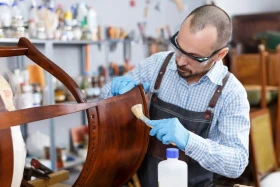DIY vs. Hiring Professionals: Making the Right Choice for Your Home Renovation in the USA
Home renovation is both thrilling and laborious. No matter whether you decide to refurbish the kitchen, remodel the bathroom, or give a whole house face-lift, there is always one important question that is raised: Should you do it yourself (DIY) or hire professionals?
One of the popular activities, home renovation, has gained considerable popularity across the USA, particularly since it is a big part of the American Dream. DIY projects have gone from strength to strength due to the increasing number of YouTube videos, Pinterest tips, and readily available tools. Aside from this, professional contractors, architects, and interior designers bring to the table elegant solutions that ensure safety, efficiency, and durability.
This blog outlines the advantages and disadvantages of each of the two approaches, hence directing you in the right decision concerning your project scope, budget, and personal goals.
Increment in Popularity of DIY in the USA
DIY home renovations have been on the rise across the states spurred by various factors:
Cost savings: The projects can become more affordable by simply not paying for labor.
Sense of accomplishment: The satisfaction that comes from completing a project on your own is unparalleled.
Material accessibility: The Internet provides a wealth of free lessons, stores such as Home Depot conduct workshops, and detailed project kits are available.
Design choices: You get to put your own stamp on things rather than resorting to someone else’s interpretation.
From painting walls to fitting shelving units, for many Americans, doing projects themselves has become a favorite pastime.
When DIY Is Suitable?
Although DIY is attractive, it might not be the best choice for all types of renovations. Most of the times it works best for:
Low-Risk and Simple
Tasks such as painting walls, installing wallpaper, landscaping, or replacing cabinet hardware are relatively easy to manage. Mistakes are minor and easy to rectify.
Budget-Conscious
If you are on a strict budget, DIY could save you a packet. A professional painter may bill you $3 to $6 per square foot, while it would cost you only half the amount if you do it yourself.
Time-Flexible
With DIY projects you can work at your own pace, whether that means weekends, evenings, or holiday breaks.
Skill-Building
For those interested in acquiring new skills, DIY projects turn out to be an educational experience. Even accomplishing small tasks can build the confidence required for tackling bigger ones in the future.
For example, a homeowner in Texas who did the entire house's interior paint themselves ends up saving almost $5,000 on labor costs and learned how to use paint tools correctly.
Disadvantages of DIY
Notwithstanding its benefits, DIY is not perfect. Among the most difficult challenges would be:
Time constraints: Unexpected learning periods cause renovations to take longer in some cases.
Error rates: Should it be the case that you redo or hire a professional to fix the problem errors, it could cost you more in the long run.
Knowledge restriction: Specialized assignments like electrical wiring, plumbing, and structural changes necessitate understanding beyond what can be learned from web resources.
Workers’ strain: Managing a large project while balancing work, family, and other responsibilities can become overwhelming.
The Case for Hiring Professionals
On the other hand, hiring professionals offers remarkable advantages that often offset the cost.
Training and Expertise
Professionals possess years of experience and training behind them. Licensed contractors, electricians, and plumbers are knowledgeable about building codes, safety, and industry best practices.
Speed and Efficiency
An expert team can accomplish more in a shorter time frame than a do-it-yourself. What might take you three months could be done in three weeks.
Assurance of Quality
Professional works yield precision, durability, and thorough finishes. Whether it is tiling bathrooms or laying hardwood floors, the outcome is generally better than the effort by the owner.
Insurance Coverage and Warranties
Most professional services come with both an insurance policy and a warranty. If anything misguided happens, you won’t have to pay for everything yourself.
Stress-free Management
The employment of professionals means that you don’t have to micromanage all the steps. They take the material sourcing, logistics and final inspections off your plate.
When Is It a Must to Hire Professionals?
Some renovations would be better in the hands of specialists. Examples are:
Electrical work: Faulty wiring can contribute to fire hazards and code violations.
Plumbing: Leaks or pipe errors can create water damage and mold issues.
Roofing: Dangerous and technically demanding, roofing requires professional safety measures.
Structural changes: Removing walls or adding extensions impacts your home’s integrity and requires permits.
HVAC systems: He heating, ventilation, and air conditioning repairs require certified technicians.
Comparing Costs: DIY vs. Professionals
Let’s look at typical renovation projects in the USA and compare costs:
|
Renovation Task |
Average DIY Cost |
Average Professional Cost |
Risk Level |
|
Interior Painting |
$200–$500 |
$1,500–$3,000 |
Low |
|
Installing Kitchen Backsplash |
$150–$400 |
$800–$1,500 |
Medium |
|
Bathroom Remodel |
$2,000–$5,000 |
$10,000–$20,000 |
High |
|
Flooring Installation (per 200 sq ft) |
$500–$1,000 |
$2,500–$4,000 |
Medium |
|
Roof Replacement |
$2,000–$5,000 |
$8,000–$15,000 |
Very High |
While DIY appears cheaper, the risk factor must be weighed. A mistake in roofing or plumbing could double repair costs.
What Should Be Considered Before Making a Decision?
If you are caught between DIY and hiring professionals, it is advisable to ask yourself:
-
Am I skilled enough?
-
How much time do I have realistically?
-
What is my budget including any mistakes I make?
-
Is it a project that requires permits or licenses?
-
How important quality and safety are to me?
Being sincere when you answer these questions will guide you to the right track.
Through the hybrid approach, both ends of the spectrum can be attained. A hybrid model for homeowners entails:
-
DIY small tasks (painting, assembling furniture, landscaping).
-
Hire professionals for the complex jobs (plumbing, electrical, roofing).
This balance ensures the company is providing the best goods and services while working smart.
For example, a couple in California during their kitchen renovation chose to paint cabinets and install shelves themselves, but hired plumbers, electrical wiremen, and countertop installers.
They saved thousands of dollars while ensuring everything is safe and durable.
Suggestions for Success in DIY
Should you decide to take a shot at DIY, here are a few tips you could follow:
Begin with basics: Try starting with some easy projects before you move to complicated ones.
Conduct extensive research: Watch videos, read manuals and consult experts online.
Are your tools good? Good tools help in easier job executions and making results professional.
Stay safe: Wear protective equipment and work in safe areas.
Be realistic with planning: Establish attainable deadlines and budget for unforeseen costs.
Tips for Hiring Professionals
When negotiating with contractors or specialists, consider the following:
Get comparative quotes: Check prices and services from at least three different providers.
Check licenses and insurance: Be sure they meet state requirements.
Ask for customer references: Existing customers can offer great insights on the trustworthiness and quality of service.
Sign an explicit contract: Include start and end times, costs, and warranties.
Keep communicating: By being involved, you are aligning expectations to what is delivered.
Conclusion
Whether one decides to do a DIY or hire professionals for home renovations in the USA is entirely influenced by their skills, budget, and project scope.
-
DIY is a budget-friendly, flexible, and satisfying way of doing things—ideal for smaller, low-risk tasks.
-
Professionals represent the skill, speed, and long-term value—mandatory for complex and risky tasks.
The hybrid agency, which is possible to provide, should be the model that is adopted by most homeowners.
The choice is entirely yours but the first thing to do is to have methodical planning, honest self-assessment, and a keen eye on quality and safety. After all, a home is not merely an investment but also a place to create, comfort, and stability in the coming years.
FAQs
Is DIY always cheaper than hiring professionals?
It is not always so. The labor cost savings of DIY is likely to be offset by any mistakes. A bad job on the electrical wiring or plumbing can wind up being far more costly than getting a professional from the outset.
What renovations should I absolutely avoid by myself?
Projects that include electrical wiring, plumbing, roofing, HVAC systems, and structural changes should always be handed over to licensed professionals due to safety and legal reasons.
How can I tell if a contractor can be trusted?
You should look out for state licenses, insurance, references, and online reviews. Always ask for a written contract and try to avoid paying the full sum in advance.
Is it possible to mix DIY and professional work in the same renovation?
Yes. A lot of homeowners opt for a hybrid approach—doing tasks themselves (painting, landscaping, shelving) while hiring professionals for the technical systems (wiring, plumbing, roofing).
What's the best way to budget for a home renovation in the USA?
Experts advise that you should set aside 10%-20% of your total budget as a contingency for unexpected expenses. Whether you do it yourself or hire professionals, renovations usually end up costing more than the initial estimates.
Does DIY add the same value to my home as professional work?
It varies. High-quality DIY projects are nice but professional renovations usually add the most value, especially bathrooms, kitchens, and structural upgrades.
How do I prevent those DIY mistakes?
Start by being small, doing extensive research, using the right tools, and following safety protocols. If at all you are uncertain, consult a professional before proceeding.


















